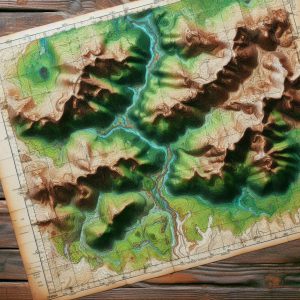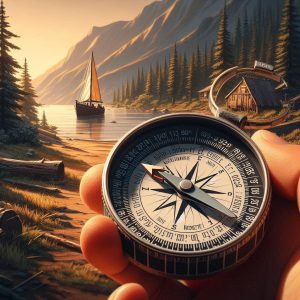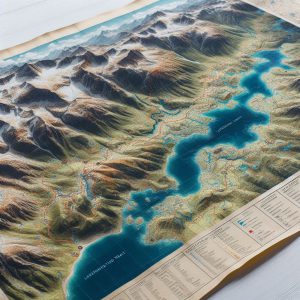Boost Your Wilderness Navigation Proficiency: A Detailed Guide for Adventurers Without GPS
Gaining mastery in wilderness navigation without the reliance on modern technology might seem daunting at first glance. However, developing crucial map and compass navigation skills is an invaluable asset that can profoundly enhance your outdoor experiences. The essence of effective navigation is rooted in a thorough understanding of your environment and the capacity to ascertain your position relative to your desired destination. A map serves as a comprehensive two-dimensional representation of the landscape, while a compass provides a trustworthy method of orienting yourself according to the cardinal directions: north, south, east, and west. By improving your skills using these tools, you empower yourself to explore the natural world freely, without the constraints of modern technology.
To embark on your navigation journey, it’s essential to familiarize yourself with the various symbols and scales displayed on a map; these elements are vital for accurately interpreting the physical landscape. Understanding how to read contour lines that indicate elevation changes is crucial, as it allows you to identify hills, valleys, and other geographical features that could influence your selected route. Additionally, becoming proficient in compass usage is equally important, equipping you to navigate the wilderness successfully without relying on GPS devices.
The compass needle consistently points toward magnetic north, enabling you to align your map with the actual terrain. To accomplish this, hold the compass flat in your hand and rotate the map until the magnetic north indicated on the compass coincides with the north shown on the map. This fundamental process, known as “orienting the map,” is essential for ensuring accuracy in your navigation efforts and preventing you from straying off your intended path.
Once your map is oriented correctly, you can use the compass to take bearings that will guide your journey. By effectively combining these two powerful navigational instruments—the map and the compass—you will navigate confidently through unfamiliar terrains, ensuring you stay on course even in the absence of modern technological devices.
Key Principles for Mastering Outdoor Navigation Skills
- Acquiring proficiency in map and compass navigation is vital for anyone venturing into wilderness exploration or participating in various outdoor activities.
- Topographic maps offer intricate details about the terrain, elevation, and natural features, which are crucial for effective navigation.
- A compass not only determines direction but also aids navigation by aligning with the map’s orientation and understanding magnetic north.
- Natural landmarks and indicators, such as unique rock formations or distinctive tree configurations, can provide valuable navigation aids when a map or compass isn’t available.
- Estimating distance and travel time is essential for planning and executing a successful navigation strategy in the wilderness.
 The Critical Importance of Topographic Maps in Wilderness Navigation
The Critical Importance of Topographic Maps in Wilderness Navigation
Topographic maps are essential tools for anyone planning an expedition into the wilderness. They provide extensive information about the physical characteristics of the terrain, utilizing contour lines to depict changes in elevation. This representation allows you to visualize the landscape’s contours and steepness, preparing you for the challenges that may lie ahead. Each contour line connects points of equal elevation, and the closeness of these lines indicates whether the slope is steep or gentle, equipping you with the necessary knowledge for effective navigation.
Mastering Contour Lines and Map Symbols for Effective Navigation
As you explore a topographic map, it’s crucial to carefully observe the patterns formed by contour lines; closely spaced lines indicate steep terrain, while widely spaced lines signify flatter areas. This understanding empowers you to anticipate potential obstacles along your route, allowing for informed navigation decisions. Moreover, topographic maps are filled with symbols representing various landmarks, including rivers, roads, trails, and different types of vegetation. Familiarizing yourself with these symbols is foundational for effective navigation, ensuring that you can utilize the map to its fullest potential and navigate confidently.
Advanced Navigation Techniques Using Topographic Maps
For instance, blue lines typically represent bodies of water, such as rivers or lakes, while green areas may indicate forests or dense vegetation. By correlating these symbols with your environment, you can confirm your location and adjust your route accordingly. Additionally, topographic maps often feature grid lines that assist you in pinpointing precise coordinates, allowing for even greater accuracy in navigation. By mastering the subtleties of topographic maps, you will deepen your appreciation for the landscape while significantly enhancing your overall navigation skills in the wild.
 Maximizing the Utility of a Compass for Accurate Directional Navigation
Maximizing the Utility of a Compass for Accurate Directional Navigation
A compass is an indispensable tool for any adventurer, providing critical assistance in directional navigation, particularly when traversing unfamiliar terrains. To utilize a compass effectively, start by holding it level in front of you and allowing the needle to stabilize. The needle will point toward magnetic north, which may vary slightly from true north due to magnetic declination—the angle between magnetic north and true north changes based on your geographical position.
Before embarking on your journey, it’s crucial to ascertain the local declination and adjust your compass accordingly. This adjustment is essential for maintaining accurate bearings, ensuring you stay on your intended course throughout your adventure. Once your compass is calibrated for declination, you can proceed to take a bearing that will direct your movement.
To take a bearing, identify a landmark you wish to navigate toward and rotate the compass housing until the orienting arrow aligns with the magnetic needle. The degree reading on the compass dial that aligns with the index line indicates your bearing. As you proceed toward your destination, periodically check your bearing to ensure you remain on the correct path.
If you find yourself straying from your intended route, reorient your compass and adjust your path as necessary. By mastering these techniques, you will cultivate confidence in using a compass as a steadfast navigational tool during any outdoor adventure.
 Leveraging Natural Landmarks and Cues for Effective Wilderness Navigation
Leveraging Natural Landmarks and Cues for Effective Wilderness Navigation
While maps and compasses are vital navigational tools, paying attention to natural landmarks and cues can significantly enhance your ability to navigate the wilderness effectively. Distinct features such as mountains, rivers, and unique trees can serve as invaluable reference points when traversing unfamiliar terrain. For example, if you know a particular mountain lies to the east of your starting position, you can use it as a reliable guide to ensure that you are heading in the correct direction.
Moreover, familiarizing yourself with the distinctive characteristics of your surroundings will aid in forming mental maps, enabling you to navigate without solely relying on tools. In addition to notable landmarks, watch for natural signs that may indicate direction or changes in terrain. The sun’s position can be a helpful guide; in the northern hemisphere, the sun rises in the east and sets in the west, providing a general sense of direction throughout the day.
Additionally, observing moss growth on trees—often more abundant on the north side—can offer valuable clues regarding orientation in dense forests. Animal trails can also provide directional hints; many animals follow established paths that can lead you toward water sources or other significant landmarks. By honing your ability to interpret these natural signs, you will bolster your skills in navigating a variety of environments.
Effectively Estimating Distance and Travel Time for Successful Wilderness Navigation
Accurately estimating distance and travel time is crucial for successful navigation in wilderness areas. Understanding how far you have traveled and the anticipated time to reach your destination allows for improved planning and helps avert unforeseen challenges. One practical technique for estimating distance is pacing—counting your steps as you walk.
On average, an adult’s stride is approximately 2.5 feet, meaning that by counting your steps over a known distance, you can gauge how far you’ve traveled based on your pace. Furthermore, consider the type of terrain and elevation changes when estimating travel time. For example, moving across flat ground typically permits quicker movement compared to navigating steep hills or rocky paths.
A common guideline suggests that you can cover roughly three miles per hour on flat terrain, but this estimate should be significantly adjusted when facing challenging landscapes. By factoring in these variables and adapting your expectations accordingly, you will be better prepared for your journey and more capable of managing your time effectively.
Crafting a Strategic Wilderness Route and Navigation Plan
Creating Your Wilderness Route for Optimal Navigation
Developing an effective navigation plan is critical prior to embarking on any wilderness adventure. Start by analyzing topographic maps of the area you intend to explore, identifying potential routes based on prominent landmarks, existing trails, and accessible water sources. As you formulate your route, consider factors such as elevation changes and terrain difficulty; ensuring that your plan is realistic and achievable is of utmost importance.
Preparing for Unforeseen Obstacles and Weather Variability
While planning your route, it’s wise to consider alternative paths in case you encounter unexpected obstacles or sudden changes in weather conditions. Having multiple options will provide you with greater flexibility during your journey and contribute to your overall safety. This adaptability is essential for a successful and enjoyable wilderness experience, empowering you to navigate any challenges that may arise seamlessly.
Developing a Comprehensive Navigation Strategy
Once you’ve outlined potential routes, create a detailed navigation plan that includes key waypoints. Mark these waypoints on your map and, if possible, note their coordinates to track your progress as you navigate through the wilderness. Additionally, incorporate estimated travel times between waypoints and identify any potential hazards that may arise along your selected route.
Ensuring a Safe and Rewarding Outdoor Experience
Thorough preparation and anticipating challenges dramatically enhance your chances of reaching your destination while enjoying a safe and fulfilling outdoor experience. A well-organized navigation strategy is vital for a successful wilderness adventure, ensuring that you can explore the great outdoors with confidence and peace of mind.
 Implementing Emergency Navigation Techniques for Unforeseen Scenarios
Implementing Emergency Navigation Techniques for Unforeseen Scenarios
Despite careful planning and preparation, unexpected situations may arise during outdoor adventures that necessitate emergency navigation techniques. One essential skill is the ability to backtrack; if you find yourself lost or disoriented, retracing your steps can often lead you back to familiar territory. To execute this effectively, pay close attention to distinctive landmarks or features along your route, which can serve as reference points when returning.
Another invaluable technique is celestial navigation, particularly useful when visibility allows—especially on clear nights or sunny days when stars or celestial bodies are visible. Familiarizing yourself with prominent constellations, such as the North Star (Polaris) in the northern hemisphere, can provide guidance, as it remains relatively fixed in position while other stars shift. By locating Polaris and determining its angle above the horizon, you can ascertain true north without relying on a compass or map.
If you have a wristwatch or smartphone as a backup, utilizing it alongside celestial navigation can bolster your sense of direction during emergencies, helping you maintain your orientation even in challenging situations.
Enhance Your Wilderness Navigation Skills: Practical Strategies for Improvement
Improving your wilderness navigation skills requires dedication and practice, but the rewards can significantly enrich your outdoor experiences. One effective strategy is to join local hiking groups or outdoor clubs, where members can share their knowledge and experiences related to navigation techniques. Engaging with seasoned navigators can provide valuable insights into best practices while offering hands-on learning opportunities across various terrains.
Another beneficial approach is to regularly practice with maps and compasses in diverse environments—whether urban settings or remote wilderness areas—to build your confidence in these essential skills. Set aside time for solo excursions where you intentionally navigate without technological aids; this method will reinforce your abilities while allowing you to connect more deeply with nature. Additionally, consider maintaining a navigation journal to document routes taken, challenges faced, and lessons learned during each adventure; this reflective practice will not only enhance your skills but also deepen your appreciation for navigating through diverse landscapes.
By embracing these techniques and continually refining your skills in map reading, compass usage, natural observation, distance estimation, route planning, emergency strategies, and sharing practical experiences with others, you will evolve into a more self-assured navigator, capable of thriving in any wilderness environment, even without the support of technology.
Common Questions About Wilderness Navigation
What does wilderness navigation involve?
Wilderness navigation encompasses the skills and techniques required to determine and maintain a route through natural, often remote, and undeveloped areas. It includes utilizing various tools and methods to stay on course and safely reach a desired destination.
What traditional methods are used in wilderness navigation?
Traditional wilderness navigation methods involve using a map and compass, interpreting topographic features, observing natural landmarks, and applying celestial navigation techniques based on the sun, moon, and stars.
Why might someone choose to navigate without GPS?
Many individuals opt to navigate without GPS for various reasons, including the desire to enhance their wilderness navigation skills, embrace the challenge of traditional methods, or prepare for potential GPS malfunctions or limited access to technology.
What advantages come with learning wilderness navigation without relying on GPS?
Learning wilderness navigation techniques independent of GPS can deepen one’s understanding of the natural environment, increase self-reliance and confidence, and provide a dependable backup plan in case of technology failures or restricted access to GPS devices.
What challenges may arise when navigating in the wilderness without GPS?
Challenges related to wilderness navigation without GPS include the necessity for advanced planning, the potential for human error, and reliance on environmental factors such as weather and visibility conditions.
The post Wilderness Navigation Techniques Without GPS appeared first on Survival Bite.
The Article Wilderness Navigation Techniques for Off-Grid Adventures Was Found On https://limitsofstrategy.com
The Article Wilderness Navigation Techniques for Off-Grid Explorers First Appeared ON
: https://ad4sc.com





Comments are closed